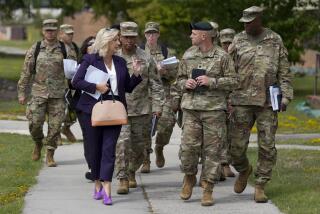West Point Looks West for Cadets : Military: The service academy has stationed a full-time recruiter in California. The move reflects the state’s population growth and its potential for sending more students to the historic Hudson River campus.
With Generals Grant, Lee, Eisenhower and MacArthur watching from a poster over his office desk, Joe Stephenson is helping to carry the flag in California for the alma mater of those famous military men--the United States Military Academy at West Point.
As the New York-based academy’s first full-time professional recruiter on the West Coast, Stephenson has discouraging news this time of year for most applicants on the crowded waiting list for admission to West Point’s graduating Class of 1995. But in the future, Stephenson said, more Californians will be getting good news.
After all, the state will gain seven or eight seats in Congress next year as a result of population growth. Because most admissions to West Point and the two other main national military academies depend on congressional nominations, that will mean more room for Californians at the schools even as other states lose slots and overall enrollment drops.
“When you look at the congressional seats in California, 45 and soon to expand to 52, that’s a pretty large chunk. This is where people are moving,” Stephenson said, explaining why West Point sent him to California last fall. The academy opened its only other office away from the historic campus on the Hudson River last year in another growth state--Texas.
Stephenson said another reason for his assignment is that California’s inner cities, with their large populations of Latinos and African-Americans, are not sending as many students to West Point as their population figures would allow.
For example, the 29th District of Rep. Maxine Waters (D-Los Angeles), covering much of South-Central Los Angeles, is sending no one this year to West Point after the one nominated candidate was disqualified because of low test scores, officials said. In contrast, the 42nd District of Rep. Dana Rohrabacher (R-Los Alamitos), which includes the affluent Palos Verde Peninsula and heavily Anglo and Asian neighborhoods of suburban Orange County, is sending eight students.
Tradition, education, family background, proximity to military bases, political attitudes and efforts by school counselors and congressional staffs contribute to such differences, say many people familiar with the academies. West Point leaders expect the American-led victory in the Persian Gulf War to boost applications this year from a wide range of students--inner-city, suburban, rural, male and female--all attracted to careers as Army officers and free college educations. But long-term imbalances among districts are not likely to be changed by foreign affairs.
So, to deal with the new congressional seats and to boost minority applicants, Stephenson and an associate are meeting with congressional staffers, school principals, counselors, teachers and students around the state. Their goal is to get young men and women thinking about West Point early on, in junior high when there is still time to improve grades and test scores and build a record in athletics and extracurricular activities to the high levels required by the academy. That effort bolsters the work of a long-existing, but part-time network of alumni volunteers, reserve officers and congressional aides.
The other night at Taft High School in Woodland Hills, for example, John Klingberg, a San Fernando Valley businessman who graduated from West Point in 1954, led a presentation to about 65 invited students and parents. There was a film about the 189-year history of West Point, including many references to famous alumni. (The film predated the Persian Gulf War and the fame of Gen. Norman Schwarzkopf, Class of 1956.) A local student completing his first year at the Point talked about how tough the discipline and courses are.
In the audience was Robert Iblings, a high school junior from Van Nuys, who plans to apply to West Point, the U. S. Naval Academy in Annapolis, Md., and the U. S. Air Force Academy in Colorado Springs, Colo.
“I want to get into the astronaut program and being a military pilot is one of the best ways to do that,” said Robert, wearing his Boy Scout uniform and Eagle Scout insignia. He said he would not be deterred by the requirement of serving six years on active duty after graduation.
His mother, Linda Iblings, had mixed feelings. “When he says he wants to be a pilot, I think of all the young men who just fought in the war. Most of them came back OK. A few didn’t,” she said. “But I want him to do what he wants. He has to follow his dreams.”
The Air Force Academy, partly because of its Western location and the Air Force’s elite image, usually attracts the most applicants from California of the service academies. The Air Force school also has an active group of part-time and volunteer recruiters in California but no full-time representative stationed here like West Point’s Stephenson, whose office is at the Los Alamitos Reserve Center.
“We are going to sit and watch how successful their program is in attracting students they wouldn’t have in the past,” Lt. Col. Barry McFarland, associate director of admissions at the Air Force Academy, said of the West Point push. “We want to see if we should jump on the bandwagon and do something akin to that.”
The U. S. Naval Academy, which often ranks second in the number of California applicants, has had a full-time representative on the West Coast for 20 years, as well as a group of volunteers. Its regional director, Tom Teshara, whose office is at Moffett Field near San Jose, said California’s new congressional districts “will be helpful and give us more openings.” The California increase is particularly significant because it runs counter to national enrollment trends, Teshara said.
Because of budget cuts and downsizing in the military, the service academies are planning to trim enrollments of new students by about 25% over the next five years so that entering classes eventually will number 1,000 at each school. Meanwhile, some East Coast and Midwest states are losing congressional seats--New York, for example, is losing three.
Most applicants to the academies need a nomination from either their House representative or U. S. Senator. Each of the 435 representatives and 100 senators is allowed up to five students at each of the military academies at one time and can nominate up to 10 candidates for each of those spots. (Some candidates to West Point, Annapolis or the Air Force academy are sponsored by the Vice President, President and military authorities. Admission to the U. S. Coast Guard Academy is not linked to nominations from elected representatives.)
“We want each congressional office to nominate 10 for each vacancy. That’s the ideal, that’s what we dream about,” said Stephenson, a civilian employee who is a Marine veteran of the Vietnam War, a former teacher and community college registrar.
In general, the academies then choose from nominees, although rankings from a congressman can be important. If some districts produce no qualified cadets, the academies fill their classes by dipping into lists from other districts. So, as total classes get smaller soon, congressional backing becomes more important. The potential number of slots for Californians at the three main academies will rise over the next few years from 705 to 810.
Of course, even with more recruiting, competition remains fierce. After test scores, grades and athletic ability are scrutinized, only about 10% of initial applicants are accepted.
Some people involved in the process claim that some congressional offices do a better job than others in encouraging applicants. “It all depends on the member of Congress. Some have no interest in this at all,” said an aide to a Republican representative, who asked not to be identified. “Maybe it’s because they don’t believe in the military.”
However, others say students’ background and education are most important.
“In Orange County, kids are geared from Day One to be active in service organizations, to get prepared for the SAT. In South-Central Los Angeles, they are just trying to get through school, get a high school diploma,” saiJ. Wills, an aide to Rep. Mervyn Dymally (D-Compton), whose 31st District includes parts of South-Central Los Angeles. “A lot of kids who have the talent are not adequately prepared.” The district traditionally has low numbers of applicants to military academies, although it is sending two students to the Air Force Academy and one to Annapolis this summer.
Applicants worry whether they need to curry favor with a congressman for a nomination.
But Stephenson noted that many congressmen have established candidate review boards to help eliminate favoritism.
Stephenson acknowledged that favoritism was more common “years and years ago,” but he added: “I think we see less of that nowadays than there ever was.”
More to Read
Sign up for Essential California
The most important California stories and recommendations in your inbox every morning.
You may occasionally receive promotional content from the Los Angeles Times.










